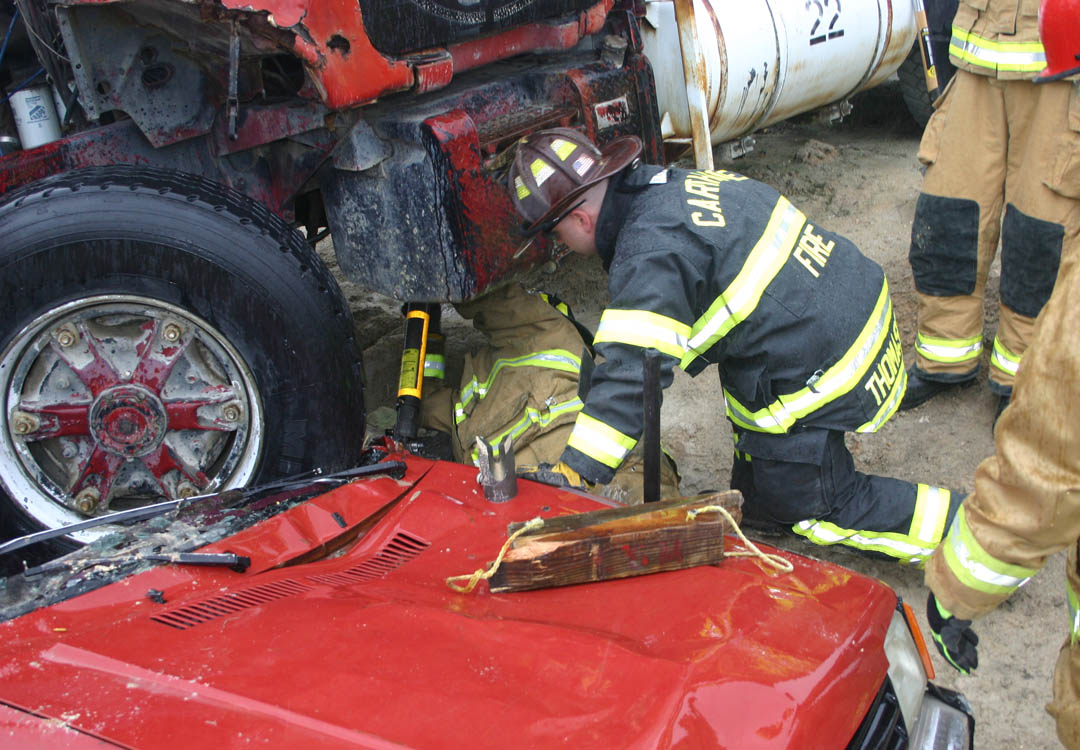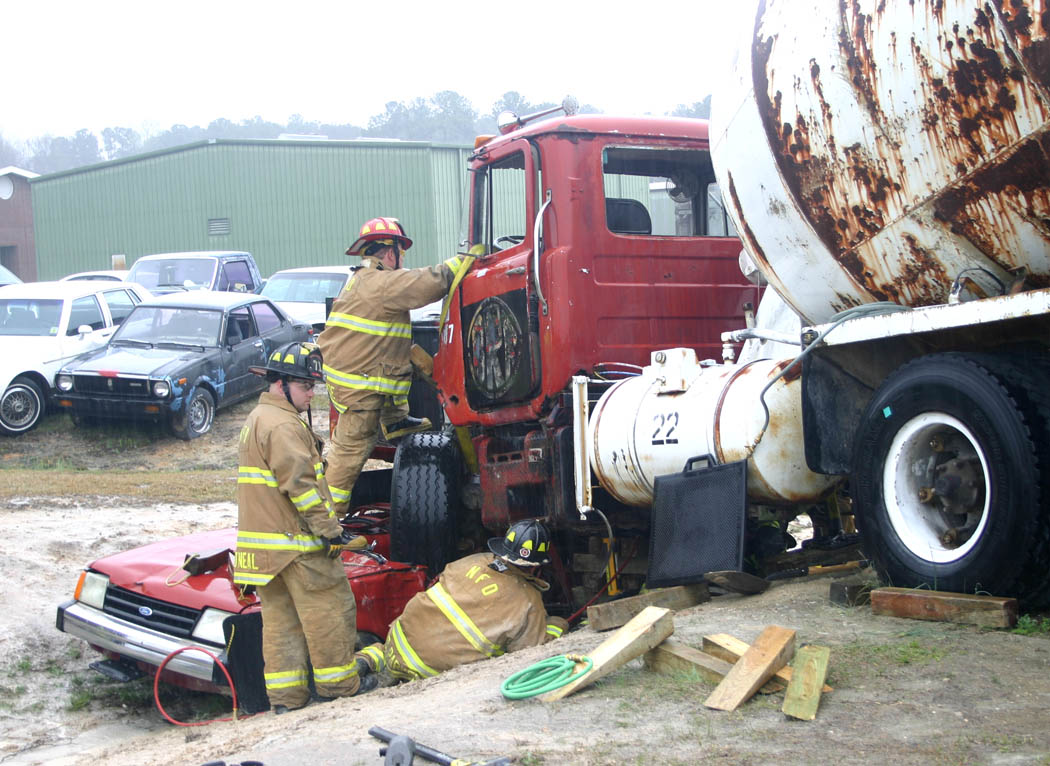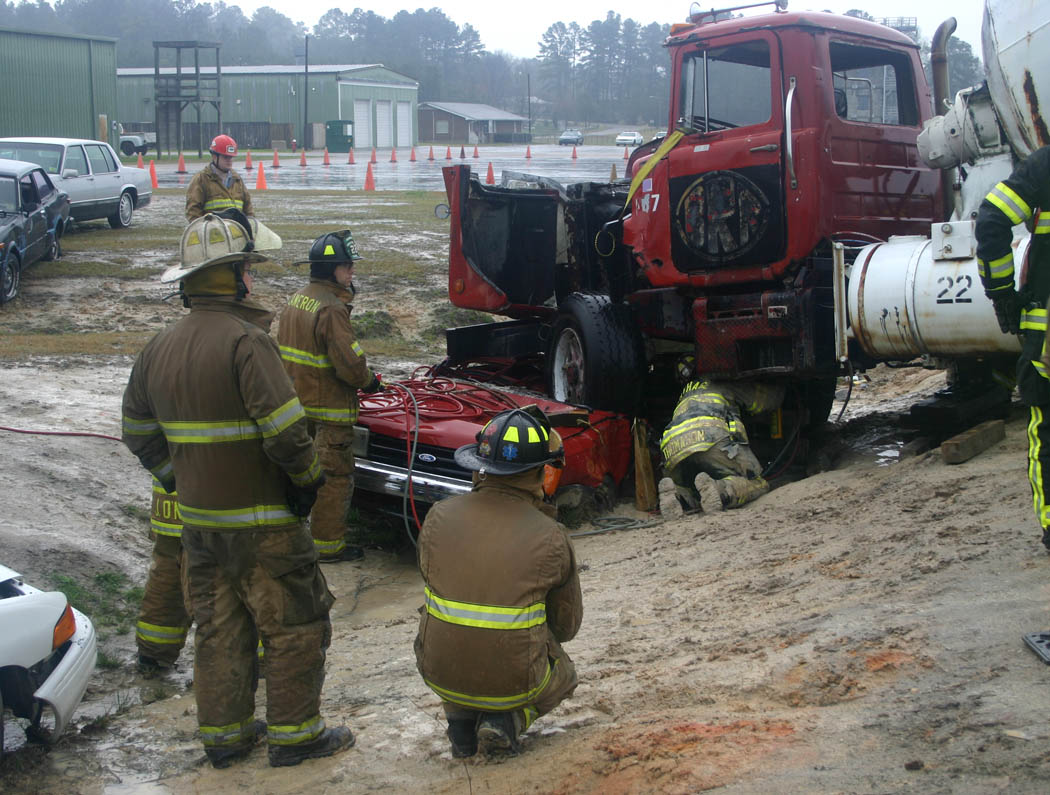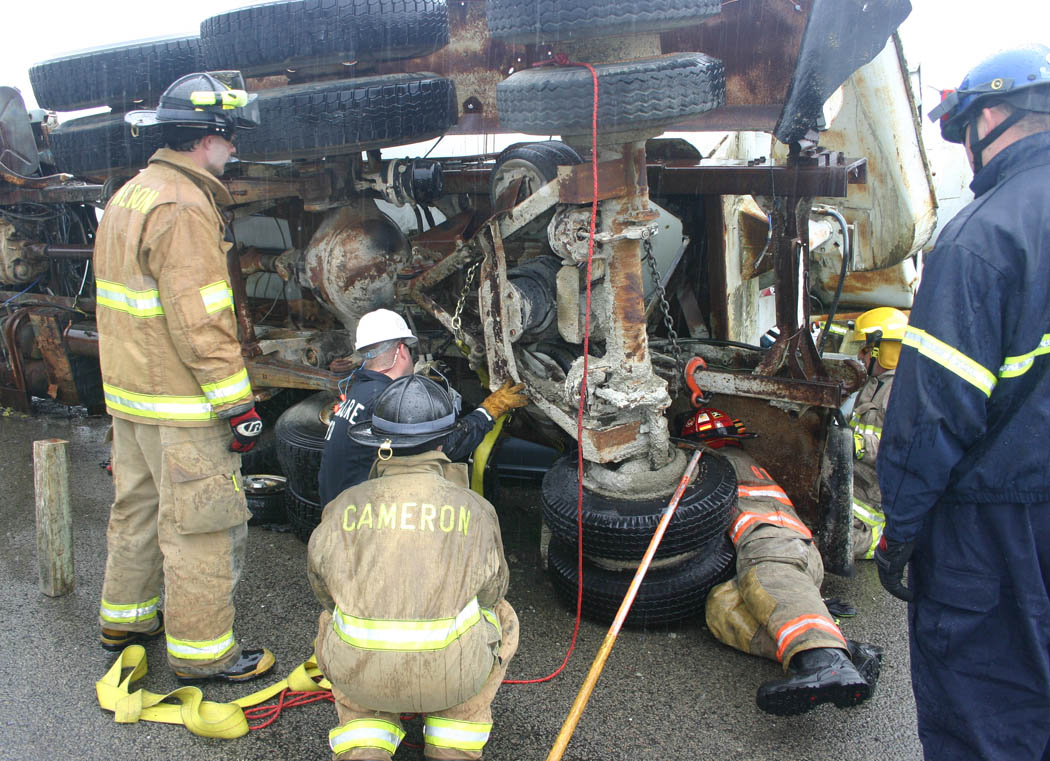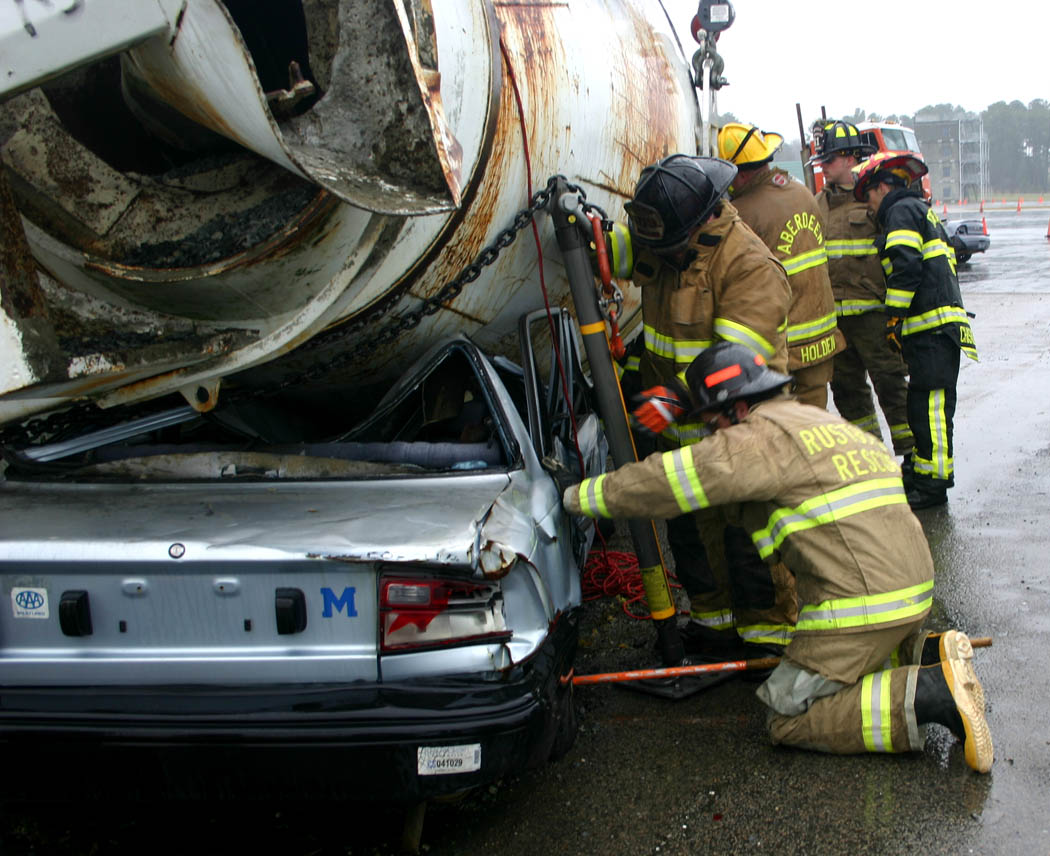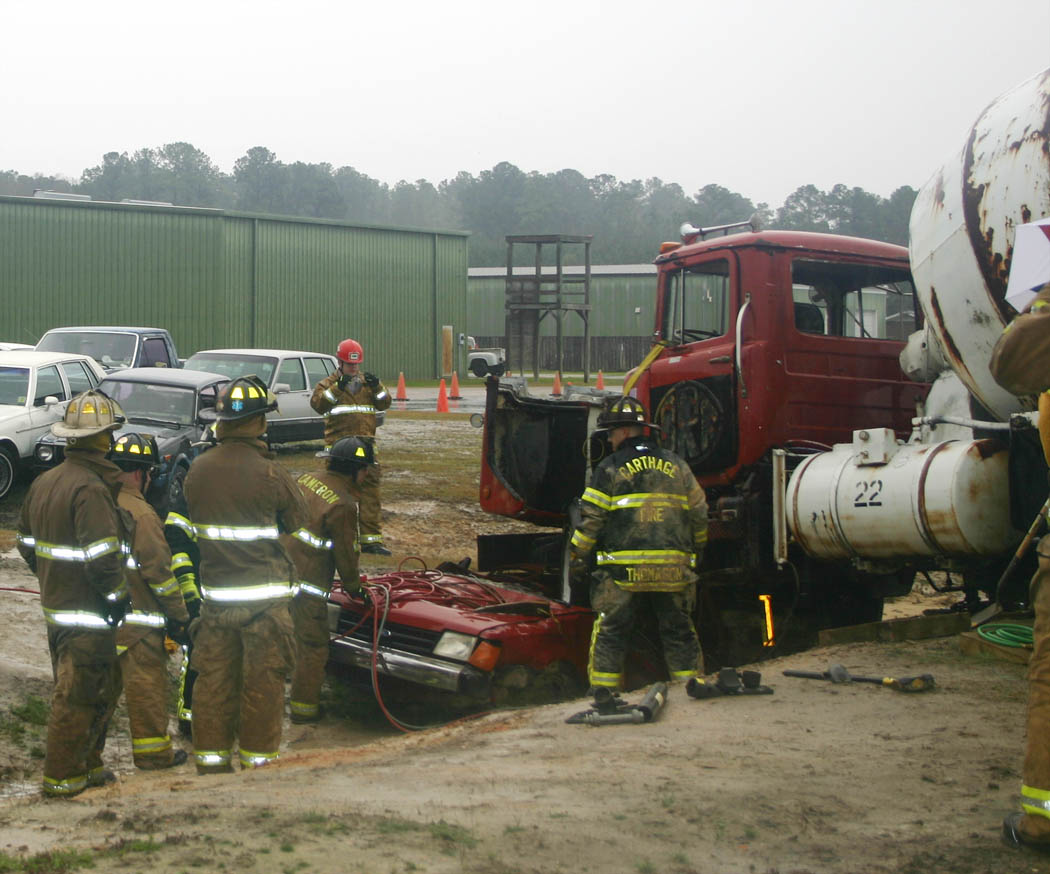SANFORD — The front wheels of a 40,000-pound concrete mixer truck pressed down on a passenger car — both wrecked in a ditch. Nearby, another concrete mixer truck had overturned onto a second car.
About 40 firefighters from multiple fire departments and rescue squads worked on the wrecks in a soaking rain. They fastened struts to stabilize the larger vehicles so they wouldn’t completely crush the smaller ones, attached chains to hold the mixers to their truck bases, placed air bags to lift the trucks, and connected tow and lift lines to remove them and get to the injured people in the cars.
Fortunately, when the truck removal work was complete, there were no passengers in either car.
The two wrecks were part of a Big Rig Rescue scenario at Central Carolina Community College’s Emergency Services Training Center. Firefighters came from Virginia, South Carolina and Indiana, as well as nine cities and towns in North Carolina, to get this specialized training.
Big Rig Rescue is one of many special programs that the ESTC offers. Since it opened in 2001, more than 600 have been held at the center, providing training for more than 9,000 emergency services personnel. That is in addition to its off-site training for local emergency services personnel. Since 2001, it has held 4,300 classes of these programs and trained more than 75,000 students.
The ESTC’s multi-day special training programs, such as Big Rig Rescue, develop skilled emergency services personnel for many counties, cities and towns. This enables the personnel to respond more effectively when the residents they serve are in situations that require their help.
For Lee County and the City of Sanford, the ESTC provides another important benefit —an economic one, according to Landis Phillips, ESTC director. Out-of-state emergency services personnel, as well as those from distant parts of North Carolina, come for training and stay in local motels, buy gas and other supplies, and eat in local restaurants.
“When the ESTC has multiple-day training scenarios that attract students from out of town, it has an impact on my business,” said Diana Sinney, manager of Holiday Inn Express, in Sanford. “My business increases by 25 percent when ESTC students are here for training.”
The Greensboro Police Department is among out-of-area agencies that take advantage of the ESTC facilities. All of the driver training for its 580 officers is done at the ESTC.
“We were using driver simulators at the department because there was nowhere in the region to train,” said Officer Mike Maul, driving coordinator for the department. “Now, we come to the ESTC. This facility is absolutely awesome, irreplaceable. It has everything we need. The Greensboro P.D. was the first in the nation to do training for pursuit-rated sports utility vehicles. This facility allows us to do it all.”
Maul said that coming to the ESTC for the training is mutually beneficial. The officers gain excellent training and the local economy benefits because the Greensboro P.D. keeps vehicles at the ESTC during the months it conducts training. Auto parts are purchased locally and much of the maintenance is done at Perry Brothers Tire Service, on East Main Street, in Sanford.
“The ESTC impacts my business tremendously,” said Chap Perry, who operates the business. “ I have a good relationship with the Greensboro P.D. When they’re training here, they’ll go through 8-10 tires each day. I have a lot of my customers because they first became acquainted with my business when they came through ESTC programs such as Basic Law Enforcement Training and motorcycle training. I estimate that training at the ESTC accounts for about $45,000 of my business each year.”
In 2000, the General Assembly provided $750,000 for the development of a regional Emergency Services Training Center for Lee, Harnett and Chatham counties. Lee County and Central Carolina Community College committed $2.5 million from the 2000 N.C. Higher Education Bond Referendum to establish it at the old Sanford-Lee County Airport, off Tramway Road. The facility provides training for all sectors of law enforcement, fire service, emergency medical services, and rescue services.
The ESTC has grown to 116 acres, providing ample space for scenarios such as train-car collisions; bus, tractor-trailer, or concrete mixer-car collisions; and other large-scale events. The new 385-foot N.C. Highway Patrol VIPER tower is used for tower rescue training. The two runways, one 4,300 and the other 3,800 feet long, are ideal for police driving, vehicular pursuit, precision intervention techniques (PIT) motorcycle safety, and other specialized training.
The new 8,500-square-foot classroom/administration building provides four classrooms plus a multipurpose room, enabling the ESTC to hold multiple classes at the same time. A live burn building and technical rescue building will shortly be in use.
“This is the best facility in the nation in terms of training scenarios,” said Billy Leach, of Asheboro, creator and instructor for the Big Rig Rescue training.
When not being used for its own emergency services training, the ESTC site contributes to the local economy through rentals to outside groups, such as private training agencies, car clubs and research facilities. Rentals have generated $108,000 since the facility opened, Phillips said. The rentals also bring large numbers of people from out of the area to Lee County to attend the events, adding to the economy while they are here.
“When the county built the new airport, I said the old airport would be perfect for a training facility,” said Perry. “By creating the ESTC, revenue is still coming into the city and county from the old airport. As the new fire tower and other facilities come into use there, it will bring even more revenue into the area. The ESTC is the best thing that ever happened.”
